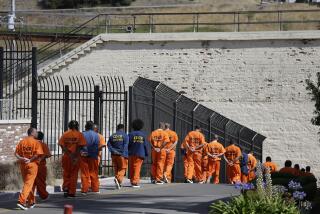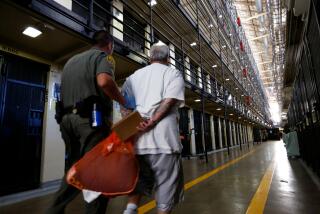An intraparty squabble on prisons
SACRAMENTO — It was completely predictable but is still fascinating to watch: Once Democrats seized firm control of California’s Capitol they wound up fighting each other.
Such is the combative nature of political animals.
In a rare twist, Republican lawmakers are siding with the Democratic governor.
The brawl is over prison crowding, which has driven a sharp wedge between the two legislative leaders: Assembly Speaker John A. Pérez (D-Los Angeles) and Senate President Pro Tem Darrell Steinberg (D-Sacramento).
“If you don’t have a good fight in this business now and then, even between allies, you’re not pushing each other hard enough,” Steinberg told me with a slight chuckle.
It’s commanding everyone’s time and attention — especially Gov. Jerry Brown’s — as the Legislature drives toward adjournment of its 2013 session Sept. 13.
Expect the prison issue to be resolved before the lawmakers go home but not much else of importance that’s less pressing.
Brown is under a federal court order to reduce the prison population to 137.5% of design capacity by Dec. 31. Three judges, ruling in a suit filed on behalf of inmates, declared that the lockups are unconstitutionally overcrowded, resulting in inadequate healthcare.
Brown has argued that the criminals get better healthcare inside prison than they would outside. But if the governor doesn’t obey the court, he faces a possible contempt citation.
The court order was issued in 2009, and the state has been dragging its feet “in open defiance,” U.S. 9th Circuit appellate Judge Stephen Reinhardt declared in April.
What does 137.5% of capacity mean? It’s complicated, and numbers shift around.
The court seemed to order the state to reduce its prison population by 9,600. But Brown is aiming for 12,000 to leave some room for future convictions.
The administration’s plan is to house 110,000 in state prisons and an additional 11,000 in private lockups — mostly out of state — and in local jails and fire camps.
Currently there are 133,000 incarcerated, down by 45,000 since 2006 and by 25,000 on Brown’s watch, he told a news conference.
We’re now down to the most hardened criminals, the governor believes, and he is refusing to turn any loose.
“If you let 10,000 people out, what happens if they decide they don’t want to go to church every Sunday and instead commit serious crimes?” he asked reporters.
Pérez stood next to the governor nodding. “We are not, any of us, willing to release a single additional prisoner,” the speaker declared.
That crosses up the court plaintiffs, whose agenda seems to be about freeing inmates as much as getting them better healthcare.
The governor’s plan to spend $315 million this year and $415 million in each of the next two to expand prison space is “an incredible waste,” contended Don Specter, the inmates’ lawyer. “Without reform of the sentencing laws, California’s prison population will continue to grow.”
The governor himself several months ago denounced the notion of pouring “more and more money down the rat hole of incarceration.” But his definition of rat hole obviously has changed.
Enter Steinberg. Specter appealed to him for help against the governor three weeks ago. The senator agreed, to a point.
A longtime champion of mental healthcare, Steinberg agreed to push for more therapy, rehab and counseling for prisoners. But he — like the governor and the speaker — opposes early release.
Steinberg offered a complex proposal that starts with Brown and the plaintiffs negotiating a court settlement. Specter is all for it. But the governor seems very unlikely to sit down with the plaintiffs. Those people really tick him off.
But if they did settle, part of the agreement would be to ask the court to postpone its Dec. 31 deadline. Steinberg suggested a three-year delay. That doesn’t seem likely, either. Both the governor and the court seem sick of this suit.
Steinberg would provide $200 million annually for rehab and mental health treatment — roughly half of what the governor is proposing for cell expansions — and create commissions to set a new prison population cap and recommend sentencing reform.
Brown and Pérez immediately rejected the idea. The governor holds the power in the Legislature — hundreds of bills currently are headed to his desk for signing or veto — and has a potent coalition of the Assembly speaker and several law enforcement groups. Steinberg is teamed with an inmates’ lawyer and prisoner-rights activists.
Won’t the Senate leader ultimately be forced to vote with the governor? “I’m not doing it,” he told me. “It’s a waste of money….
“Do we do what has failed us the last three decades … or do we do something smarter?”
The majority of Senate Democrats are solidly behind him, Steinberg says.
Truth is, Senate and Assembly leaders often don’t get along. There are rivalries between the houses, and they habitually play games harassing each other, especially at the end of a legislative session.
But seldom is it this bad. These two houses couldn’t even agree on when to take their summer vacations. They started and ended in different weeks.
Pérez, in a radio interview last week, uttered one of the more provocative comments I’ve ever heard one leader say about another of the same party. He opined that if Steinberg were to allow a Senate vote on the governor’s plan, “it would pass” — meaning that the leader couldn’t even control his own house.
You’ve got to love it if you’re a legislative spectator.
Look for Brown to toss Steinberg a bone and strike a deal.
Find more Skelton columns at https://www.latimes.com/news/local/politics.
More to Read
Start your day right
Sign up for Essential California for news, features and recommendations from the L.A. Times and beyond in your inbox six days a week.
You may occasionally receive promotional content from the Los Angeles Times.







